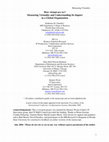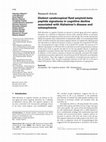and Ilze Zigurs
Sajda Qureshi �
PARADOXES AND
PREROGATIVES
GLOBAL VIRTUAL
COLLABORATION
IN
Ubiquitous computing is not only influencing our lives,
butCase
our livelihoods.
Indeed,
career environments
choices and paths
study findings
from traditional
several corporate
will
require
fundamental
attitude
adjustments.
suggest that successful virtualization does not depend on
the degree of technological sophistication. It’s how
the tools are used that matters.
Increasing virtualization of the work environment is requiring people to manage
relationships, share knowledge and expertise, and coordinate joint activities in
entirely new ways. Collaborative technologies make virtualization possible. These
technologies range from electronic meeting systems and videoconferencing to
newsgroups and calendaring systems (see box). Even such traditional technologies as
the telephone and email play a critical role in supporting virtualized work
environments.
Organizations that use collaborative technologies expect to share resources, manage relationships, and bring dispersed skills and knowledge to
bear on joint projects that span global operations.
Yet employees complain they are not motivated to
use the technology, do not have the time or skills,
or do not see rewards for participating. Why is
reality so distant from the ideal?
We address this question using data from case
studies collected over the past two years via interviews, participant observations, electronic transcripts,
and informal conversations. The data represents
multinational companies using collaborative technologies for a variety of tasks and degrees of virtualization. The results suggest both paradoxes and
lessons learned about global virtual collaboration.
COMMUNICATIONS OF THE ACM December 2001/Vol. 44, No. 12
85
�The Paradoxes
Collaborative technologies in virtual environments enable better face-to-face meetings. Geographically dispersed work groups can draw upon
collaborative technologies to support rapid formation and continuing development of relationships,
common goals, and communities of interest. The
senior leadership team at Shell Services International
comprises 18 globally distributed people who make
decisions on strategic issues of high impact at three
in-person meetings per year. They use simple technologies such as telephone conferencing and email
for ongoing collaboration between meetings. A document management system for sharing briefing
materials proved too difficult to use and update
because team members traveled so much. Other
technologies would be tested as they became more
generally accepted.
The Central and Eastern European node within
Shell Europe Oil Products (SEOP) Retail Network
relies on a core retail team and an extended team of
planners, engineers, and other staff. Occasional faceto-face meetings are meaningful from ongoing virtual collaboration seen as essential for accomplishing
detailed tasks. Team members are trained in trust
building, communication etiquette, agenda sharing,
and timely response. NetMeeting is viewed as ideal
for communicating management decisions to the
rest of the team and for sharing documents. It also
Virtual asset teams at Shell Exploration and Production are distributed teams of experts brought
together for a single purpose—such as developing a
new technology—and they disband when the project is completed. Each asset team is provided with
training on defining shared objectives, agreeing on
roles and responsibilities, and starting an expertise
network. Alta Vista Forum is used to access and
share data, and email and phoning provide communication among dispersed members. The environment helps team members focus on common goals
and bring diverse skills to bear on joint projects. Virtual collaboration between European and Latin
American team members revealed instances of misunderstanding due to cultural differences in perception. Although these differences occasionally
impeded communication, the structured approach
of the technology ensured high task focus.
Cultural differences are seen as a challenge at
Monitor Company, a worldwide consulting firm
that forms ad hoc strategy teams commissioned by
clients. Their Knowledge Network is built with
Lotus Notes and provides access to information services, document sharing, and email. These collaborative technologies deliver fast responses to clients by
enabling the right mix of people and knowledge
matched to specific client problems.
Simple and adaptable technologies enable
more complex virtual collaboration. Virtualization means rapid change, high diversity,
and distributed resources. Flexibility is
Companies and Technologies
more important than ever and successful
Cases studied: Andersen Consulting, Cap Gemini Ernst and
technologies combine simplicity with
Young, KPMG, McKinsey, Monitor Co., Shell (SSI, SEOP, SEP),
adaptability. Solvision embodies this idea,
Solvision.
since it exists only as a virtual organization
Collaborative technologies used: Calendaring systems, chat
communicating solely through collaborarooms, desktop videoconferencing, email, e-meeting systems,
tive technology. Rather than a physical
information and knowledge repositories, newsgroups, personal
office, this consultancy provides each
information managers, project management systems, teleemployee with a laptop, GSM phone, and
phone conferencing, video whiteboards, workflow systems.
an ISDN connection to communicate
with each other and clients. The company’s intranet runs Livelink, which provides
access to profiles, agendas, project information, and
alleviates the need to travel long distances to meet. knowledge communities. Consultants and clients
Email, phoning, and scheduling software supple- may physically meet at Solvision’s Grand Café to
ment this environment for sharing knowledge and establish social contact.
experience.
Even in traditional work environments, simple
Cultural differences increase the resolve to collaborative technologies enable more complex
connect in virtual collaborations. The need to activities to be carried out. Through Arthur Anderexchange knowledge and the task-focused design of sen’s Knowledge Xchange System—which uses
many collaborative technologies creates an environ- Lotus Notes on the company’s internal worldwide
ment where people can deal with cultural differences network—all employees have access to over 2,000
to a much greater extent than expected, or perhaps databases. These databases contain information
in a way that is different from traditional venues. about projects, methods, tools, technical specifica86
December 2001/Vol. 44, No. 12 COMMUNICATIONS OF THE ACM
�Why is reality so distant from the ideal?
tions, contacts, and best practices. Consultants use build on their core competencies, and draw upon
email (primarily from client sites) to communicate networks of personalized interorganizational relaand databases to customize services. In-house devel- tionships.
opers collaborate on innovative products using email
Virtual communities have implications for the
and application-sharing programs. Senior managers creation of knowledge in virtual organizations.
and partners use videoconferencing for meetings Communities of minds evolve in virtual spaces and
with U.S. headquarters and other international act on social networks to create communities of
offices.
practice. Virtual collaboration supports the creation
Communities arise outside explicit technology of communities of practice where people work
design. Truly networked organizations find that together to achieve joint goals. These communities
people go beyond explicit designs for communica- comprise individual experts, groups, and even orgation to create fortuitous links. These
unexpected communities of diverse
Lessons Learned
knowledge can foster innovation. A
knowledge management and organiza- • Management motivation has a direct effect on virtual
tional memory information system at Cap
collaboration.
Gemini Ernst and Young makes it possible • Collaborative roles emerge, but must be made more explicit.
for people to connect in entirely new • Tasks that benefit most from virtual collaboration are those
ways. Consultants can move freely
requiring knowledge sharing, structure, and detailed teamthrough the organization, forming hybrid
work.
projects and switching expertise among • Cultural diversity can enhance the value of virtual collaboration.
departments, thanks to the knowledge • Training is important for successful virtual collaboration and
marketplace on the company’s state-ofsuccessful training programs put work practices at the forethe-art intranet. Questions can be posted
front.
on specific issues to which people within • Technology is a device, not a driver, of virtual collaboration.
the firm generally answer. The virtual
space on the knowledge marketplace is
divided into consultant-defined subjects known as nizations that can access each others’ valued infor“marketspots.” When someone posts a question or mation and resources. An organization may tap into
an answer in a marketspot, its members receive an the assets of other organizations by mobilizing its
email message. The consultant can also see short own members or directors who belong to these other
biographical data about other consultants within the organizations. Politically active organizations gain
marketspot. Consultants can locate colleagues who access to politically relevant resources through memhave marketspot experience, enabling them to con- bers and directors. By cultivating diversified ties to
nect on the basis of their expertise. In this way, spe- large numbers of community organizations capable
cial interest communities have emerged within the of supplying resources, an organization’s or a group’s
organization and brought the diverse skill and exper- dependence on a single source is significantly
tise of its globally distributed consultants to bear on reduced. Furthermore, collective action through
specific projects.
communities of practice takes place by formally allocating people and resources to tasks and providing
The Prerogatives
mechanisms for coordination. Collective action can
These experiences show virtual collaboration mat- be mobilized through virtual spaces supported by
ters. Collaborative technologies present opportuni- electronic communication and group decision supties for sharing knowledge and skill, for mobilizing port systems.
resources toward joint efforts, and for providing
The main challenge facing modern organizations
more innovative and customized products and ser- is recognizing and maximizing core competencies.
vices. It is a prerogative for those able to master While core competencies may be codified within
global virtual collaboration to tap into the value of corporate databases and organizational systems, they
their emerging virtual communities, manage and are most often dispersed in different parts of the
COMMUNICATIONS OF THE ACM December 2001/Vol. 44, No. 12
87
�Truly networked organizations find that people go beyond
explicit designs for communication to create fortuitous links.
organization, lie within the minds of different
employees, and are created through personal interaction. Sharing this personalized knowledge is supported by collaborative technologies. For example,
virtual collaborations about how to solve a particular product defect are recorded and become part of
the organization’s memory, to be referenced later by
other employees facing similar situations. Used this
way, virtual collaboration enables the creation and
in these case studies—tasks requiring structure and
tasks requiring detailed teamwork. Shell’s virtual
asset teams have highly structured, one-time projects
easily managed within virtual collaborations. At
Monitor Company and Shell CEE, collaborative
technologies enabled detailed tasks to be carried out.
Manage stakeholder expectations. Collaborative
technologies developed to suit users’ espoused needs
are not necessarily used. KPMG’s K-World is a very
sophisticated intranet system whose use
does not meet expectations. Cap Gemini
Guidelines
Ernst and Young’s virtual project office and
My Galaxy represent high-end collabora• Develop and communicate norms across remote and diverse
tive technologies. Still, the most popular is
units.
the simple knowledge marketplace Web
• Develop and sustain shared goals within diverse groups.
enabling communities to form around spe• Identify and support interaction of like-minded individuals
cific work problems.
or special interest groups across traditional boundaries.
Take advantage of diversity. Culture is
• Foster exchange of personalized knowledge.
not
the enormous barrier for virtual collab• Expand boundaries of knowledge beyond the organization’s
oration
some predicted. The Shell and
walls.
Monitor
cases suggest focusing on tasks
• Mobilize distributed resources quickly.
and goals is easier in virtual environments
• Match people and other resources to rapidly changing needs.
than in traditional ones, so take full advantage of diversity in global collaborations.
maintenance of knowledge networks through which
Collaborative technologies can provide enduring
people in different parts of the organization cooper- and empowering prerogatives for virtual collaboration
ate and consult with each other to provide knowl- by fostering the emergence of virtual communities,
edge-intensive services.
enabling core competencies to be maximized, and
We are witnessing a progression from networks personalizing interorganizational relationships. Servsupporting formal interorganizational relationships ing the needs of team members is the starting point
such as strategic alliances, to a world in which the for these payoffs from global virtual collaboration. c
key value of virtual collaboration is the personalization of interorganizational relationships. Nonroutine, interorganizational relationships are facilitated, Sajda Qureshi (squreshi@fac.fbk.eur.nl) is an assistant professor
and routine relationships are changed, when deci- of Information Management at Erasmus University, The
Netherlands.
sions made in virtual workspaces are seen to be legit- Ilze Zigurs (zigurs@spot.colorado.edu) is Mutual of Omaha
imate. This has implications for the provision of Chair of Information Science and Technology at the University of
customized services provided jointly by a number of Nebraska at Omaha, NE.
organizations.
Moving Forward
The accompanying box lists guidelines for reaping
the benefits of virtual collaboration in the face of the
paradoxes discussed here. The following strategies
are also essential for successful collaborations:
Make explicit choices about virtual tasks. Two
kinds of tasks worked best for virtual collaboration
88
December 2001/Vol. 44, No. 12 COMMUNICATIONS OF THE ACM
Permission to make digital or hard copies of all or part of this work for personal or
classroom use is granted without fee provided that copies are not made or distributed
for profit or commercial advantage and that copies bear this notice and the full citation on the first page. To copy otherwise, to republish, to post on servers or to redistribute to lists, requires prior specific permission and/or a fee.
© 2001 ACM 0002-0782/01/1200 $5.00
�
 Sajda Qureshi
Sajda Qureshi































